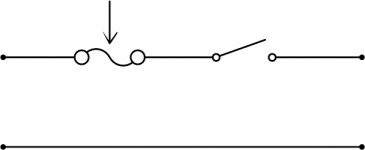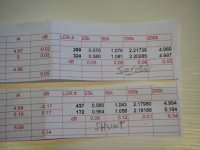'For now its not time to make it look pretty 🙂' Fair point 😱
All done, and hopefully not burning-out on the work bench😀
Cutting of the DC jack from an adapter has certainly widen my choice 😉
I'll keep you posted.
If that is a switch on top of the input DC jack then it is certainly wired incorrectly and THAT is what is killing the Wall warts.
EDIT: Skip the fuse, wire the switch in series like this:
Attachments
Last edited:
Member
Joined 2002
If that is a switch on top of the input DC jack then it is certainly wired incorrectly and THAT is what is killing the Wall warts.
EDIT: Skip the fuse, wire the switch in series like this:
That is exactly what i was looking for but i was to buys and doing some coding stuff, so i didn't look to far, right now the idea is to remove the switch and that input jack.
Jase
Once you switch to on, it effectively shorts out the PS.
You want the +ve to wire to one pin of the switch and then wire the other pin of the switch to the rest of the circuitry. One wire connects the ground of the PS and the ground of the circuitry.
You want the +ve to wire to one pin of the switch and then wire the other pin of the switch to the rest of the circuitry. One wire connects the ground of the PS and the ground of the circuitry.
is the bulb tester still glowing with only the transformers connected?
I don't have an IEC socket on this case. Maybe I should think about adding a 3 pin wall socket to the bulb tester.
Member
Joined 2002
I don't have an IEC socket on this case. Maybe I should think about adding a 3 pin wall socket to the bulb tester.
that is what i would do 🙂
Jase
The L/S has been powered up for 6 hours without any problems, so it looks like its OK.
Thanks for the help, I feel quite embarrassed about this. But I guess if some other newb benefits from my mistake it will be worth while 😱
Thanks for the help, I feel quite embarrassed about this. But I guess if some other newb benefits from my mistake it will be worth while 😱
The L/S has been powered up for 6 hours without any problems, so it looks like its OK.
Thanks for the help, I feel quite embarrassed about this. But I guess if some other newb benefits from my mistake it will be worth while 😱
Never was so much owed by so many to so few 😛😉😀
Member
Joined 2002
The L/S has been powered up for 6 hours without any problems, so it looks like its OK.
Thanks for the help, I feel quite embarrassed about this. But I guess if some other newb benefits from my mistake it will be worth while 😱
Every one has a moment 🙂 Glad we helped, i bet it was the switch 🙂
Every one has a moment 🙂 Glad we helped, i bet it was the switch 🙂
Ive had too many moments recently 😱
Ive had too many moments recently 😱
This can clearly be seen if we look at your avatar. I would choose another one because this one might bring you bad luck. Or is this your real façade 🙄
I have met him. This is what he really looks like.
An externally hosted image should be here but it was not working when we last tested it.
Limited range of attenuation
I have populated and tested the pcb provided by dbv-projekt. I also used the Bom listed by Orpheus in the "pcb" thread. LDRs from Uriah. The pcb has trimmer pots in both legs of the series ldr's. I am using a 100k log Alps pot.
I've tested the circuit with a 9V battery and using ipod as input with volume on ipod max. Output to headphones. I can hear very low volume from 7 o'clock to 1 o'clock and then slow increase and then very narrow range to full volume 2 o'clock to 5 o'clock. Voltage from lm7805 is 5V. I've tried the trimmers down to min resistance and then to max but still there is very little change in range of attenuation.
Measured resistance from input to output at various spots on the rotation of the pot dial are 7 o'clock =5.5k, 9 o'clock=5.5k, 12 o'clock=4.85k, 1 o'clock=4.0k, 3 o'clock=1.8k, 5 o'clock=40 ohm. For Left channel. Right tracks similarly.
These are the values used for shunt and series.
So, How do I get a more useful -full range of attenuation throughout the turn of my pot?
Do I need a different value of Pot given the values of the matched ldr's?
Any Ideas?
Is this just a limitation of using ldr's as atttenuator?
Also for those using Orpheus BOM, the trimmers listed have the screw on the side. At least that is what Digikey sent me. The Alps pot doesn't fit readily in the holes and needed some bending and coaxing of leads to fit. Not a big deal.
Thanks.
JC
I have populated and tested the pcb provided by dbv-projekt. I also used the Bom listed by Orpheus in the "pcb" thread. LDRs from Uriah. The pcb has trimmer pots in both legs of the series ldr's. I am using a 100k log Alps pot.
I've tested the circuit with a 9V battery and using ipod as input with volume on ipod max. Output to headphones. I can hear very low volume from 7 o'clock to 1 o'clock and then slow increase and then very narrow range to full volume 2 o'clock to 5 o'clock. Voltage from lm7805 is 5V. I've tried the trimmers down to min resistance and then to max but still there is very little change in range of attenuation.
Measured resistance from input to output at various spots on the rotation of the pot dial are 7 o'clock =5.5k, 9 o'clock=5.5k, 12 o'clock=4.85k, 1 o'clock=4.0k, 3 o'clock=1.8k, 5 o'clock=40 ohm. For Left channel. Right tracks similarly.
These are the values used for shunt and series.
So, How do I get a more useful -full range of attenuation throughout the turn of my pot?
Do I need a different value of Pot given the values of the matched ldr's?
Any Ideas?
Is this just a limitation of using ldr's as atttenuator?
Also for those using Orpheus BOM, the trimmers listed have the screw on the side. At least that is what Digikey sent me. The Alps pot doesn't fit readily in the holes and needed some bending and coaxing of leads to fit. Not a big deal.
Thanks.
JC
Attachments
Yep, thats a problem with the LDR based pot. It ramps up real fast once it starts getting toward loud then it gets loud FAST. The trimmer wont change this at all, it will increase the impedance max. Different impedance sounds different and sometimes the wrong value will give your amp/cdp trouble.
Your 2-5Oclock is actually nice. Most people dont get LOUD that far in the turn. It usually is before that.
See the log pot has a taper to it and the LDRs have a taper to them and when things get loud both tapers are increasing quickly in value so the interaction of the tapers happens real fast.
Uriah
Your 2-5Oclock is actually nice. Most people dont get LOUD that far in the turn. It usually is before that.
See the log pot has a taper to it and the LDRs have a taper to them and when things get loud both tapers are increasing quickly in value so the interaction of the tapers happens real fast.
Uriah
jcon2, other limitation is they don't go absolutely quiet. Just testing my attenuator, finished this morning, listening to What's Going On by Marvin Gaye. Amp volume turned up to max (amp is Peter Daniel's gainclone), attenuator at minimum volume, still audible, level a bit lower to what I normally listen to. No opinion yet on LDR v Alps blue velvet pot! Thanks again to Uriah and Oliver for LDRs and PCB! Mark
Member
Joined 2002
jcon2, other limitation is they don't go absolutely quiet. Just testing my attenuator, finished this morning, listening to What's Going On by Marvin Gaye. Amp volume turned up to max (amp is Peter Daniel's gainclone), attenuator at minimum volume, still audible, level a bit lower to what I normally listen to. No opinion yet on LDR v Alps blue velvet pot! Thanks again to Uriah and Oliver for LDRs and PCB! Mark
Well thats not good, i guess one could use a DPDT switch for mute.
Yep, thats a problem with the LDR based pot. It ramps up real fast once it starts getting toward loud then it gets loud FAST.
Uriah
Hmm. This creates a bit of problem with my wife, "Why is the volume control so touchy?"
George,
Is this the same with the production Lightspeed?
Paul,
Does your Lightspeed remote control address this issue? IE can you provide a smoother broader range of attenuation?
Seems like there should be an easy fix here but it isn't coming to me.
I wanted to use this to control a briangt gainclone. I'm hesitant to put it in if I know there will be immediate pushback
Thanks again Uriah and Oliver for your work.
Jack C
Hmm. This creates a bit of problem with my wife, "Why is the volume control so touchy?"
George,
Is this the same with the production Lightspeed?
C
In the production Lightspeed Attenuator that I make, it behaves much like a normal pre with a log pot, that is from zero to about 2 o'clock it is very gradual (12 o'clock being good loud level) then starts to come on strong after 2 o'clock to the end, that is is with 87-92db speakers and with amps of 1-2 volts input to clip.
You must remember this is with 4 x matched NSL32RS2S's, not two matched pairs (which will give different ramping), also a dual log 100k pot for the voltage feed. And the power supply as I've done, not some of the others around in some of these threads.
Cheers George
- Home
- Source & Line
- Analog Line Level
- Lightspeed Attenuator a new passive preamp

